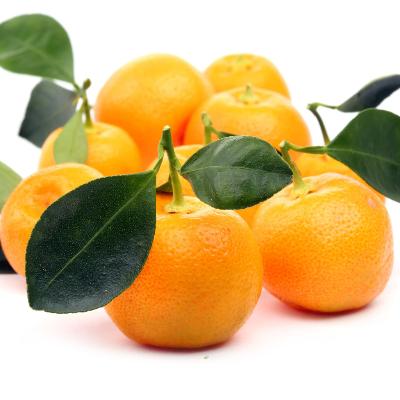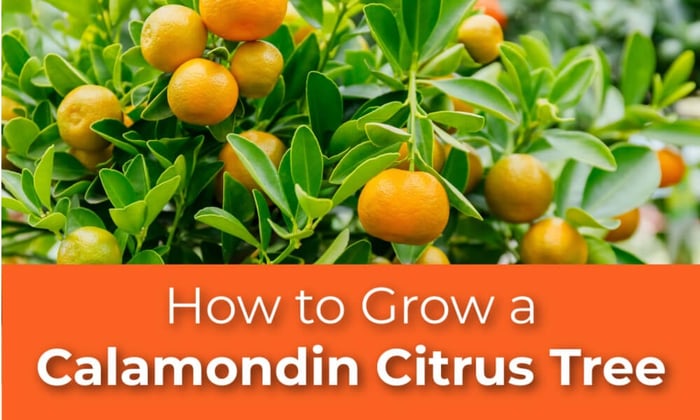How to Grow a Calamondin Citrus Tree
Calamondin, also known as Calamansi or Philippine lime, is a small, round citrus fruit that is native to the Philippines and other parts of Southeast Asia. It's a hybrid between a kumquat and a mandarin orange, and tastes like a sour mandarin or sour tangerine. Calamondin fruits are typically about the size of a golf ball, and they have a thin, tangerine-like peel and a juicy, sour-tasting pulp. They are commonly used in Filipino, Malaysian, Indonesian, and Thai cuisines to add a tangy flavor to dishes, beverages, and condiments. You simply squeeze them with your fingers or a lemon squeezer. They do have seeds.
Calamondin trees are recommended for first time or beginner citrus growers, because they are resilient and one of the most prolific citrus producers that we offer. Calamondin trees are considered to be ever-bearing, meaning that under the right conditions, they can produce flowers and fruit continuously. This makes the Calamondin tree not only a great food producer, but a beautiful and ornamental tree.
In tropical countries like the Philippines and Vietnam, calamondin fruit stays green even when it is ripe. That is because tropical countries do not have the cold night temperatures that turn citrus fruit orange or yellow. In most US states, calamondin fruit will turn fully orange when they are ripe. They will also be soft to the touch and can be picked off of the tree fairly easily. Because of their delicate peel, we suggest that you harvest your fruit with scissors or pruners, as pulling the fruit off the tree can leave a hole at the top where the peel is attached to the branch.
Calamondin trees grow best outdoors in USDA Zones 8-11. For Zones 4-7, you can grow a calamondin citrus tree in a pot and bring it indoors for the winter. They must be protected if temperatures fall below 32 F.
Here are some care tips on how to grow a Calamondin citrus tree.
1. Choosing a Pot: Select a pot with good drainage holes to grow a calamondin citrus tree, like these planters. The size of the pot should accommodate the tree's root system as it grows. For the primo sized calamondin trees, a pot with a diameter of at least 10'-14" inches is recommended.
Planting in the ground: For in-ground planting, plant the tree in a prepared area about 3x the diameter of the pot, and as deep as the root ball. That soil should be well-draining and loose, allowing for root growth. Plant your tree at the same depth as the pot, keeping the crown of the roots just above the soil line. Water thoroughly after planting.
2. Soil: Use a well-draining chunky potting mix specifically formulated for citrus trees, such as our Primo Potting Mix. This potting mix is a 5-1-1 type mix, which is a popular growing medium for container citrus trees. It consists of 5 parts orchid bark, 1 part citrus specific potting mix and 1 part perlite.
3. Location: Place the potted tree in a location that receives at least 8 hours of sunlight. Citrus trees, including calamondin trees, require plenty of sunlight to thrive. On very long, hot summer days, you can position your tree in a spot that receives some afternoon shade. Especially if you notice that the leaves are experiencing sunburn or sunscald.
4. Watering: Water your tree regularly, keeping the soil consistently moist but not waterlogged. Use your finger to check the top inch or two of soil; if it feels dry, it's time to water. During the growing season (spring and summer), you may need to water more frequently. Reduce watering in the colder months.
There is not a hard and fast rule on how often to water your citrus, because there are many variables to consider, such as the weather, your potting mix and the size and material of your container (plastic, wood, terra cotta) .
5. Fertilization: Feed your calamondin tree with a balanced fertilizer such as Romeo Fertilizer or G&B Organic Citrus & Fruit Tree Fertilizer. Follow the manufacturer's instructions for application rates and timing. Fertilize during the active growing season (spring and summer) to support healthy growth and fruit production.
6. Pruning: Prune your tree in the early spring to maintain its shape and remove any dead or diseased branches. Regular pruning helps improve air circulation and sunlight penetration, which is essential for healthy growth. Click here to read more about pruning your citrus tree.
7. Pollination: Calamondin trees are self-pollinating, which means they don't necessarily require another tree for pollination. However, having multiple citrus trees nearby can improve cross-pollination and potentially enhance fruit production.
8. Pests and Diseases: Keep an eye out for common citrus pests like aphids, scale insects, and spider mites. Treat any infestations promptly using appropriate insecticides or insecticidal soaps, such as Captain Jack's Insecticidal Super Soap. Additionally, monitor your tree for signs of diseases such as citrus canker or citrus greening, and take necessary steps to prevent or manage these issues.
9. Frost Protection: If you live in a colder climate, consider bringing the potted tree indoors or providing frost protection during the winter months. Citrus trees are sensitive to frost and cold temperatures. Click here to read more about bringing your citrus tree inside for the winter.
10. Repotting: As your calamondin tree grows, it may outgrow its current pot. Repot the tree into a larger container every 2-3 years or when you notice the roots becoming overcrowded or the soil mix has started to break down. Move up in pot size gradually until your tree has reached maturity. Too big of a pot can cause root problems. Make sure that the rootball mostly fills out the inside of the pot.
Remember that to grow a Calamondin citrus tree, especially if you're not in an ideal climate, you should be prepared to provide consistent care and attention to your tree's needs. If you're growing your tree indoors or in a non-native climate, consider using artificial lighting to supplement sunlight during the darker months.
If you have any more questions on how to grow a calamondin citrus tree, email us! cs@fourwindsgrowers.com
$65.00
--OVERVIEW-- Now Available! 36"-48" Calamondin Semi-Dwarf Trees The Calamondin citrus fruit, also called Calamansi, is prized in the Philippines. This variety has prolific fruit production. Its small sour orange fruit used as you would use a lime. Calamondin trees have… read moreCalamondin/ Calamansi Semi-Dwarf Tree





